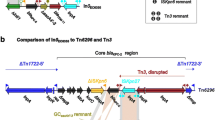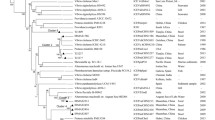Abstract
The dissemination of many antibiotic resistance genes has arisen among members of the family Enterobacteriaceae. The dissemination mechanism of these antibiotic resistance genes is closely linked with insertion sequence common region 1 (ISCRl). Thus, caution must be taken in clinical settings to prevent further dissemination of these antibiotic resistance genes. A nomenclature system of ISCRl variants, important for the antibiotic resistance dissemination, was proposed. The proposed system can designate all ISCRl variants on the basis of the detection time and by considering amino-acid substitution(s) compared with ISCRla. This nomenclature system of ISCRl variants can be applied to 19 groups (ISCRl to ISCR19) of the ISCR family and help some researchers to correctly designate new ISCR subgroups.
Similar content being viewed by others
References
Ambler, R.P. 1980. The structure of β-lactamases. Philos. Trans. R. Soc. London B Biol. Sci. 289, 321–331.
Bauernfeind, A., I. Stemplinger, R. Jungwirth, R. Wilhelm, and Y. Chong. 1996. Comparative characterization of the cephamycinase bla CMY-1 gene and its relationship with other β-lactamase genes. Antimicrob. Agents Chemother. 40, 1926–1930.
Bennett, P.M. 2008. Plasmid encoded antibiotic resistance: Acquisition and transfer of antibiotic resistance genes in bacteria. Br. J. Pharmacol. 153, S347–357.
Chen, Y.T., T.L. Lauderdale, T.L. Liao, Y.R. Shiau, H.Y. Shu, K.M. Wu, J.J. Yan, I.J. Su, and S.F. Tsai. 2007. Sequencing and comparative genomic analysis of pK29, a 269-kilobase conjugative plasmid encoding CMY-8 and CTX-M-3 β-lactamases in Klebsiella pneumoniae. Antimicrob. Agents Chemother. 51, 3004–3007.
Doi, Y., N. Shibata, K. Shibayama, K. Kamachi, H. Kurokawa, K. Yokoyama, T. Yagi, and Y. Arakawa. 2002. Characterization of a novel plasmid-mediated cephalosporinase (CMY-9) and its genetic environment in an Escherichia coli clinical isolate. Antimicrob. Agents Chemother. 46, 2427–2434.
Jeong, J.Y., H.J. Yoon, E.S. Kim, Y. Lee, S.H. Choi, N.J. Kim, J.H. Woo, and Y.S. Kim. 2005. Detection of qnr in clinical isolates of Escherichia coli from Korea. Antimicrob. Agents Chemother. 49, 2522–2524.
Lee, S.H., S.H. Jeong, and S.S. Cha. 2006. Screening for carbapenem-resistant Gram-negative bacteria. Lancet Infect. Dis. 6, 682–684.
Lee, J.H., S.H. Jeong, S.S. Cha, and S.H. Lee. 2009. New disturbing trend in antimicrobial resistance of Gram-negative pathogens. PLoS Pathog. 5, e1000221.
Lee, S.H., S.H. Jeong, and Y.M. Park. 2003. Characterization of bla CMY-10, a novel, plasmid-encoded AmpC-type β-lactamase gene in a clinical isolate of Enterobacter aerogenes. J. Appl. Microbiol. 95, 744–752.
Sorum, H., T.M. L’Abee-Lund, A. Solberg, and A. Wold. 2003. Integron-containing IncU R plasmids pRAS1 and pAr-32 from the fish pathogen Aeromonas salmonicida. Antimicrob. Agents Chemother. 47, 1285–1290.
Stokes, H.W., C. Tomaras, Y. Parsons, and R.M. Hall. 1993. The partial 3′-conserved segment duplications in the integrons In6 from pSa and In7 from pDGO100 have a common origin. Plasmid 30, 39–50.
Thompson, J.D., D.G. Higgins, and T.J. Gibson. 1994. CLUSTAL W: Improving the sensitivity of progressive multiple sequence alignment through sequence weighting, position-specific gap penalties and weight matrix choice. Nucleic Acids Res. 22, 4673–4680.
Toleman, M.A., P.M. Bennett, and T.R. Walsh. 2006a. Common regions e.g. orf513 and antibiotic resistance: IS91-like elements evolving complex class 1 integrons. J. Antimicrob. Chemother. 58, 1–6.
Toleman, M.A., P.M. Bennett, and T.R. Walsh. 2006b. ISCR elements: novel gene-capturing systems of the 21st century? Microbiol. Mol. Biol. Rev. 70, 296–316.
Toleman, M.A. and T.R. Walsh. 2008. Evolution of the ISCR3 group of ISCR elements. Antimicrob. Agents Chemother. 52, 3789–3791.
Verdet, C., G. Arlet, G. Barnaud, P.H. Lagrange, and A. Philippon. 2000. A novel integron in Salmonella enterica serovar Enteritidis, carrying the bla DHA-1 gene and its regulator gene ampR, originated from Morganella morganii. Antimicrob. Agents Chemother. 44, 222–225.
Walsh, T.R. 2006. Combinatorial genetic evolution of multiresistance. Curr. Opin. Microbiol. 9, 476–482.
Author information
Authors and Affiliations
Corresponding author
Additional information
These authors contributed equally to this work.
Rights and permissions
About this article
Cite this article
Sohn, S.G., Lee, J.J., Song, J.S. et al. Nomenclature of ISCRl elements capable of mobilizing antibiotic resistance genes present in complex class 1 integrons. J Microbiol. 47, 514–516 (2009). https://doi.org/10.1007/s12275-009-0054-5
Received:
Accepted:
Published:
Issue Date:
DOI: https://doi.org/10.1007/s12275-009-0054-5




